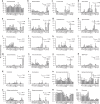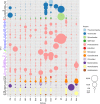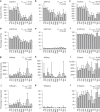The sponge microbiome within the greater coral reef microbial metacommunity
- PMID: 30967538
- PMCID: PMC6456735
- DOI: 10.1038/s41467-019-09537-8
The sponge microbiome within the greater coral reef microbial metacommunity
Abstract
Much recent marine microbial research has focused on sponges, but very little is known about how the sponge microbiome fits in the greater coral reef microbial metacommunity. Here, we present an extensive survey of the prokaryote communities of a wide range of biotopes from Indo-Pacific coral reef environments. We find a large variation in operational taxonomic unit (OTU) richness, with algae, chitons, stony corals and sea cucumbers housing the most diverse prokaryote communities. These biotopes share a higher percentage and number of OTUs with sediment and are particularly enriched in members of the phylum Planctomycetes. Despite having lower OTU richness, sponges share the greatest percentage (>90%) of OTUs with >100 sequences with the environment (sediment and/or seawater) although there is considerable variation among sponge species. Our results, furthermore, highlight that prokaryote microorganisms are shared among multiple coral reef biotopes, and that, although compositionally distinct, the sponge prokaryote community does not appear to be as sponge-specific as previously thought.
Conflict of interest statement
The authors declare no competing interests.
Figures






Similar articles
-
A comparison of prokaryote communities inhabiting sponges, bacterial mats, sediment and seawater in Southeast Asian coral reefs.FEMS Microbiol Ecol. 2019 Dec 1;95(12):fiz169. doi: 10.1093/femsec/fiz169. FEMS Microbiol Ecol. 2019. PMID: 31633774
-
Composition of Archaea in seawater, sediment, and sponges in the Kepulauan Seribu reef system, Indonesia.Microb Ecol. 2014 Apr;67(3):553-67. doi: 10.1007/s00248-013-0365-2. Epub 2014 Jan 30. Microb Ecol. 2014. PMID: 24477923
-
The putative functional ecology and distribution of archaeal communities in sponges, sediment and seawater in a coral reef environment.Mol Ecol. 2015 Jan;24(2):409-23. doi: 10.1111/mec.13024. Epub 2015 Jan 7. Mol Ecol. 2015. PMID: 25438824
-
Composition and Predictive Functional Analysis of Bacterial Communities in Seawater, Sediment and Sponges in the Spermonde Archipelago, Indonesia.Microb Ecol. 2015 Nov;70(4):889-903. doi: 10.1007/s00248-015-0632-5. Epub 2015 Jun 14. Microb Ecol. 2015. PMID: 26072397
-
Marine sponge microbial association: Towards disclosing unique symbiotic interactions.Mar Environ Res. 2018 Sep;140:169-179. doi: 10.1016/j.marenvres.2018.04.017. Epub 2018 Apr 27. Mar Environ Res. 2018. PMID: 29935729 Review.
Cited by
-
Host specificity of the gut microbiome.Nat Rev Microbiol. 2021 Oct;19(10):639-653. doi: 10.1038/s41579-021-00562-3. Epub 2021 May 27. Nat Rev Microbiol. 2021. PMID: 34045709 Review.
-
Development and validation of an experimental life support system to study coral reef microbial communities.Sci Rep. 2024 Sep 11;14(1):21260. doi: 10.1038/s41598-024-69514-0. Sci Rep. 2024. PMID: 39261551 Free PMC article.
-
Natural experiments and long-term monitoring are critical to understand and predict marine host-microbe ecology and evolution.PLoS Biol. 2021 Aug 19;19(8):e3001322. doi: 10.1371/journal.pbio.3001322. eCollection 2021 Aug. PLoS Biol. 2021. PMID: 34411089 Free PMC article.
-
Major ocean currents may shape the microbiome of the topshell Phorcus sauciatus in the NE Atlantic Ocean.Sci Rep. 2021 Jun 14;11(1):12480. doi: 10.1038/s41598-021-91448-0. Sci Rep. 2021. PMID: 34127690 Free PMC article.
-
Heterotrophy in the earliest gut: a single-cell view of heterotrophic carbon and nitrogen assimilation in sponge-microbe symbioses.ISME J. 2020 Oct;14(10):2554-2567. doi: 10.1038/s41396-020-0706-3. Epub 2020 Jun 29. ISME J. 2020. PMID: 32601480 Free PMC article.
References
Publication types
MeSH terms
Substances
LinkOut - more resources
Full Text Sources
Research Materials
Miscellaneous

